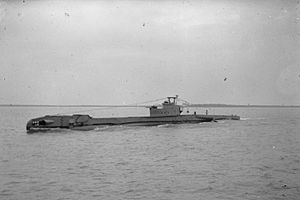HMS Trump (P333)
 HMS Trump
| |
| History | |
|---|---|
| Name | Trump |
| Builder | Vickers Armstrong, Barrow |
| Laid down | 31 December 1942 |
| Launched | 25 March 1944 |
| Commissioned | 8 July 1944 |
| Identification | Pennant number P333 |
| Honours and awards | Malaya 1945[1] |
| Fate | Scrapped at Newport, Wales, August 1971 |
| Badge |  |
| General characteristics | |
| Class and type | T-class submarine (Group III) |
| Displacement |
|
| Length | 273 ft (83.2 m) |
| Beam | 25 ft 6 in (7.8 m) |
| Draught |
|
| Propulsion |
|
| Speed |
|
| Range | 4,500 nmi (8,334 km) at 11 knots (20 km/h) surfaced |
| Test depth | 350 ft (107 m) max |
| Complement | 63 |
| Armament |
|
HMS Trump (pennant number P333) was a British submarine of the third group of the T class. She was built by Vickers-Armstrongs, Barrow, and launched on 25 March 1944. So far she has been the only ship of the Royal Navy (RN) to bear the name Trump. She spent the majority of her life attached to the 4th Submarine Squadron based in Australia. She was kept in service following the war and was refitted for greater underwater performance, and was the final RN submarine to be posted in Australia, departing in January 1969. She was sold off and broken up for scrap in August 1971.
Design and description
HMS Trump was one of the group three of T-class submarines.
Service
World War II
Trump was
During her Far East service, Trump sank the Japanese guard boat No. 15 Shosei Maru on 13 May;[6] a Japanese sailing vessel on 24 May; and two coasters, one on 29 May and the other on 1 June. She sank a tanker on 5 June and together with her sister boat HMS Tiptoe, she sank a Japanese cargo vessel on 9 August.[5]
Also with Tiptoe, Trump carried out an attack on a convoy on 3 August.[6] Although it was escorted by a Japanese patrol boat, they successfully sank Tencho Maru, an army cargo ship, with the sinking credited to Tiptoe.[5][6]
Post war
Trump survived the war and continued in service with the Royal Navy. Trump was one of several all-welded T-class submarines rebuilt for greater underwater performance.
In 1960, Trump, along with Taciturn and Tabard, rejoined the 4th Submarine Flotilla at Sydney, Australia. There, they operated with units of the Far East Fleet, the Royal Australian Navy, and the Royal New Zealand Navy. In June 1964, she participated in the "NEWS EX" anti-submarine exercise in the Hauraki Gulf off the coast of New Zealand.[9]
Trump underwent refits at
Notes
- ^ Mason RN (Rtd), Lt Cdr Geoffrey B. "HMS Trump - T-class Submarine". Naval-History.net. Retrieved 24 January 2011.
- ^ a b Akermann (2002): p. 386
- ^ McCarthy (2006): p. 12
- ^ a b McCarthy (2006): p. 13
- ^ a b c d "HMS Trump (P 333)". Uboat.net. Retrieved 24 January 2011.
- ^ a b c Cressman, Robert J. "Chapter VII: 1945". The Official Chronology of the US Navy in World War II. ibiblio.org. Retrieved 24 January 2011.
- ^ a b c Akermann (2002): p. 383
- ^ Hulme, P.D. "A fresh look at the Five Streamlined 'T' class submarines of the early 1950s". Barrow Submariners Association. Archived from the original on 1 November 2011. Retrieved 24 January 2011.
- ^ "NZ Naval Board Report – 1964". RNZN Communicators Association. Retrieved 24 January 2011.
- ISBN 978-0-86840-817-0.
- ISBN 978-0-7546-6431-4.
- ^ "Oberon Class - The First Australian Submarine Squadron". Submarine Institute of Australia. Archived from the original on 19 February 2011. Retrieved 24 January 2011.
- ^ "HMAS OXLEY (II)". Royal Australian Navy. Retrieved 24 January 2011.
References
- Akermann, Paul (2002). Encyclopaedia of British Submarines 1901-1955. Penzance, Cornwall: Periscope Publishing. ISBN 1-904381-05-7.
- McCartney, Innes (2006). British Submarines 1939-45. Osprey Publishing. ISBN 978-1-84603-007-9.
External links
- "HMS Trump (P 333)". uboat.net.
- "Triumph to Truncheon". British Submarines of World War II. Archived from the original on 2 January 2009.
